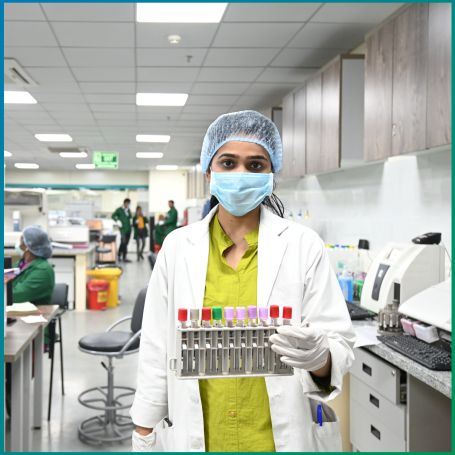
The C/S ET Tip Test is a diagnostic procedure used to detect infections in the endotracheal (ET) tube, which is a medical device commonly used in patients requiring mechanical ventilation.

The ET tube is inserted into the trachea to ensure a clear airway and to assist with breathing during surgery or in critically ill patients. However, as with any medical device that is inserted into the body, the ET tube can become a site for bacterial or fungal colonization, leading to infections that may complicate a patient's recovery. The C/S ET Tip Test involves taking a sample from the tip of the endotracheal tube, culturing it to identify any pathogens, and performing sensitivity testing to guide the most effective treatment.
1] Detecting Ventilator-Associated Pneumonia (VAP) - One of the most common and serious complications associated with the use of an ET tube is ventilator-associated pneumonia (VAP). VAP occurs when bacteria or fungi enter the lungs through the tube, leading to infection. The C/S ET Tip Test helps identify the exact pathogens responsible for VAP, ensuring that appropriate antibiotics or antifungals are administered early to treat the infection.
2] Identifying Pathogens - The test helps to accurately identify the specific bacteria or fungi responsible for an infection in patients with an ET tube. Common pathogens that can be identified include Pseudomonas aeruginosa, Staphylococcus aureus, and Acinetobacter species. Identification of the exact microorganism helps in selecting the right treatment, as different pathogens require different drugs.
3] Guiding Targeted Treatment - The sensitivity testing done alongside the culture provides valuable information about which antibiotics or antifungal medications will be most effective against the isolated pathogens. This allows healthcare providers to administer a targeted treatment, which is more effective and reduces the likelihood of side effects and drug resistance.
4] Prevention of Complications - Early and accurate identification of infections in the ET tube can help prevent severe complications such as systemic infections, sepsis, or prolonged hospital stays. Since patients on mechanical ventilation are often critically ill, timely treatment of infections is essential to avoid further deterioration of their condition.
1] Sample Collection - The first step in the C/S ET Tip Test is the collection of a sample from the tip of the ET tube. This is usually done by a healthcare professional, such as a respiratory therapist or a doctor, using a sterile swab. In some cases, the sample may be aspirated directly from the tube using a syringe. The sample is collected carefully to avoid contamination and is usually obtained when signs of infection are suspected.
2] Transport to the Laboratory - Once the sample is collected, it is sent to a laboratory for processing. The sample is placed in a sterile container and transported under controlled conditions to ensure that the microorganisms remain viable for culturing.
3] Culture of the Sample - In the laboratory, the sample is cultured in a specialized medium that encourages the growth of bacteria or fungi. The culture is incubated at the optimal temperature, typically 37°C (body temperature), to allow microorganisms to grow. The culture may take 24 to 48 hours, depending on the type of pathogen and its growth characteristics.
4] Identification of the Pathogen - After the microorganism has grown, it is identified based on its characteristics such as shape, color, and biochemical properties. In some cases, molecular techniques may also be used for faster and more accurate identification.
5] Sensitivity Testing - The next step is antibiotic sensitivity testing, which determines which antibiotics or antifungal medications are effective against the isolated pathogen. The lab will expose the pathogen to various drugs to determine the ones that inhibit its growth. This helps the physician choose the most appropriate treatment.
6] Result Interpretation - The results typically take 48 to 72 hours to return. Once the test results are available, the healthcare team can review the pathogen identification and the sensitivity profile to prescribe the most effective treatment.
Choosing Diagnopein for the C/S ET Tip Test in Nagpur ensures precise, reliable, and rapid diagnostic results for infections related to endotracheal tubes. Diagnopein’s advanced laboratory facilities use state-of-the-art techniques to accurately culture and identify pathogens, providing detailed antibiotic or antifungal sensitivity profiles. Their expertise in detecting ventilator-associated pneumonia (VAP) and other tube-related infections helps clinicians select the most effective treatment, improving patient outcomes. With a focus on timely results, excellent customer care, and a commitment to high-quality testing, Diagnopein is the trusted choice for healthcare providers in Pune seeking reliable and efficient infection management.
1. Culture Method
2. Sample
3. Colony Count
4. Organism(s) Isolated
5. Culture Report: Culture yields growth of
6. Culture isolated after 7 days :
7. Culture isolated after 14 days:
8. Culture isolated after 21 days:
9. Ampicillin
10. Amikacin
11. Amoxicillin clavulanate
12. cefoperazon+sulbactam
13. Cefuroxime
14. Cefepime
15. Cefotaxime
16. Ciprofloxacin
17. Ertapenem
18. Gentamicin
19. Imipenem
20. Meropenem
21. Norfloxacin
22. Nitrofurantoin
23. Piperacillin-tazobactam
24. Trimethoprim-Sulfamethoxazole (Cotrimoxazole)
No, the test involves a simple collection of a sample from the ET tube, which is generally painless for the patient.
The test can detect bacterial or fungal infections, including ventilator-associated pneumonia (VAP) caused by pathogens like Pseudomonas aeruginosa, Acinetobacter, or Staphylococcus aureus.
A healthcare provider collects a sample from the tip of the ET tube using a sterile swab or syringe, which is then cultured and tested in a laboratory.
It is done to detect infections, such as ventilator-associated pneumonia (VAP), in patients with an ET tube and to guide the choice of the most effective antibiotics or antifungals.